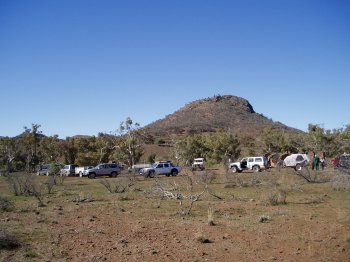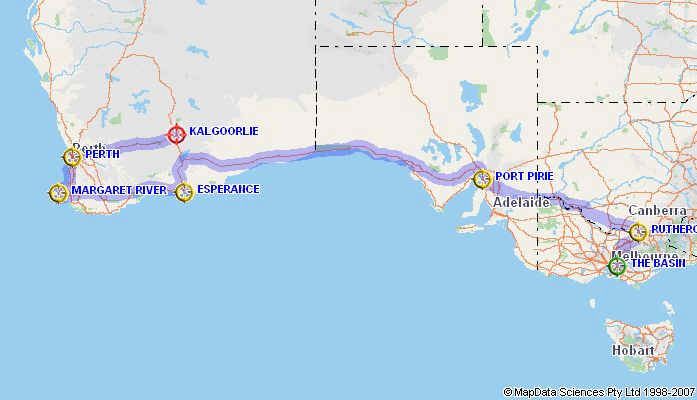| ABS NextG
trial over the Nullarbor. July 26th to 31st Aug 2007 see the service: www.alchester.com.au/absoutback.htm for outback communication link details See the results of the trial. |
 |
| ABS NextG
trial over the Nullarbor. July 26th to 31st Aug 2007 see the service: www.alchester.com.au/absoutback.htm for outback communication link details See the results of the trial. |
 |
Alchester Business Systems is dependent upon communications when
away from the CBD where GSM and landline communications is just taken for
granted. But once away from the coast line, and the CBD, the ability to
connect directly to customer equipment, send emails, and stay in touch with the internet
becomes a challenge in the vast outback areas of Australia. Attempting VPN, IPSEC,
ssh or indeed, RDP online activities presents a bigger challenge. In 2006, ABS
undertook a fairly gruelling 9000 km trip through the 'near' outback of NSW and QLD via
such out of the way places as Cobar, Winton, Longreach and Charleville. Rather than
focus on totally out-of-the way places, it was more appropriate to consider areas where
there are still reasonable traffic loads, be they off the main track.
For that trial, the purpose was to compare the signal strength and ability to communicate
collaboratively over CDMA from a 'moving' hotspot': The ABSoutback
rig! That test was very successful, with only the odd location failing
to gain a connection point. In fact the only area that was noticably unavailable was
a 60 kilometre stretch from Hughenden to Charters Towers through the infamous township of
Corfield where they held the 106th annual horse race that year. With all that
time available for enjoying the races - who really wanted internet, you might ask.
But alas, the solidity of CDMA and its availability is drawing to an end, as this country
moves to replace it with Next-G. And so ABSoutback is again being
put to the test. You see, 2-way satellite, wireless hotspot, GSM and fixed
line communications are just not an option, if you need interaction. The reasons
are: lack of availability, latency in communication or simply lack of sufficient
population to justify the provisioning of suitable alternatives.
So along comes NextG (or 3G or 'wireless' and other confusing
names....) The technology we're talking about is one which operates on radio
towers, relies on line-of-sight, not unlike what CDMA did, but has a stronger signal
(supposedly) and provides longer reach between towers than CDMA. As a result, less
towers are needed, and greater coverage can be served. Anyway - that's the selling
lines by the providers. As a demanding and dependent user, we've equipped
ourselves with a 7dB external magnetic antenna to ensure best possible reception from a
moving target, and coupled the technology to a Unix based internet server that permits
significant caching and filtering of data, to ensure a better quality transmission of
useful information. And then we've tested it, stationery, moving, and in
varying positions relative to the signal source, to guage its effectiveness.
Why collaborative? Well, why congest the airwaves with multiple
receivers when a hosting solution can provide the answer more efficiently.
That way a lot of the INTRA-communication between travelling parties can occur immediately
on the private wireless link (even travelling in convoy at 100km/h!) - and at the same
time, collectively access the internet through a single shared connection - thus
maximising the caching performance for all concerned. The real advantage
though, comes from the ability to actually use NextG from simple devices like PDA's that
otherwise have no way of connecting to the outside world. All you need is a device
with an 802.11g wifi port, and you're connected to the ABSoutback!
This trip will be fairly kind to the NextG network, as the bulk of the trip will be
through fairly habitated areas, but NOT CBD or highly ppulated coastal areas (where GSM
and NextG are well focussed). The journey takes us along the Murray and goes
cross country to the tip of Spencer Gulf. At that point, the Nullarbor run from Pt
Augusta to Norseman will check out what coverage is like on a solitary road stretching the
Great Australian Bight and through the arid plains. From there, the southern coast
of Western Australia from Esperance around via Albany and Margaret River, should test the
more popular areas of that part of Australia, ending up in Perth. The return
leg via Kalgoorlie, again will test the ability of signals in such out of the way
locations - yet well trafficed areas, and ones used by both commerce and domestic users,
who will expect constant connection given the demands of the region.
Being a flat run for most of the journey, one specific feature that will be worth noting,
will be the ability of the NextG towers to emit a long distance, uninterrupted signal
compared to what we've experienced with CDMA previously.
Stay tuned for the results!
UPDATE: results of trip documented here: http://www.alchester.com.au/pers/gaz/abs2007perth.htm
